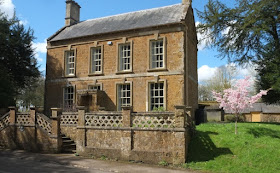Tuesday, May 31, 2016
Great Tew, Oxfordshire
Small mercies
This vicarage is a pleasant architectural surprise on the way to the church at Great Tew, different from, but complementary to, the thatched cottages that make up much of the village – although a vicarage on the way to a church is hardly a surprise. The house was originally built in 1696 and has been altered and expanded several times since, notably in the early-19th century, when such features as the bold surrounds to the windows were added. Actually these bands of limestone are not quite as bold as they might appear in the photograph, because when you look at them closely, there are very narrow roll mouldings around the insides of the surrounds, reducing and softening their bulk in a rather pleasing way.
The porch to the off-centre doorway is another touch from the early-19th century. This was the period in which the village of Great Tew was being landscaped and transformed – probably by the gardener and designer John Claudius Loudon – into an ideal Picturesque village (for more on this, see one of my earlier posts). I know some of my fiends will be irritated by this off-centre door, lamenting the fact that this building is not in the beautifully symmetrical mode of classical English houses. But maybe it works in terms of the internal layout and anyway I rather like it. No doubt that’s my perverse appreciation of ‘All things counter, original, spare, strange,’ as Gerard Manley Hopkins has it, coming into play.*
The ornamental wall in front of the house is hardly ‘spare’, although it is dappled, in a sort of fish-scale pattern. This works well. The lower, solid part of the wall retains the rising ground behind, while the fish-scale patterned part acts as the stone equivalent of a garden fence, defining the boundary and letting light through at the same time. This wall is probably early-19th century too and manages to combine strength and delicacy in a single structure. A small architectural mercy. Glory be to God for it…or to its architect and builder anyway.
- - - - -
*See Gerard Manley Hopkins, ‘Pied Beauty’ (‘Glory be to God for dappled things…’).

Now, this is really beautiful! And in your usual insightful fashion, you actually try and say WHY it is so pleasing. I'm sure the magic word "mouldings" has a lot to do with it!
ReplyDeleteGreat Tew, Oxfordshire was indeed a Godly place. I was hoping you would show something of Great Tew Manor, home of Lucius Cary, 2nd Viscount Falkland and later Chancellor to King Charles. He would have known the church, and walked past where the vicarage now stands. I'm guessing the village was beautified because of it's closeness to Oxford and its fame as an influential address ... Falkland started the Great Tew Circle here in the 1630s, 'According to the writings of Edward Hyde (much later when he was the Earl of Clarendon), the gatherings and discussions themselves were modeled on those of Cicero and Erasmus, with guests being welcome to differ on points of view. Discourse also took place around the dinner table, which Hyde likened to the "Convivium Philosophicum or Convivium Theologicum ("philosophical-" or "theological feast") and to Erasmus' Convivium Religiosum ("godly feast")."'
ReplyDelete"Falkland was the friend of John Hales and William Chillingworth, and was celebrated in verse by Ben Jonson, John Suckling, Abraham Cowley and Edmund Waller, and celebrated in prose by Edward Hyde, who calls him the "incomparable" Falkland, and draws a delightful picture of his society and hospitality." High praise indeed.
Joseph: Thank you. I could have also mentioned the harmonious proportions of the 12-pane sash windows.
ReplyDeleteSally: Thank you. Yes, Lucius Cary was a fascinating figure. I've not been able to photograph the big house, but it was certainly celebrated for its gatherings of intellectuals. John Aubrey said it was 'like a Colledge, full of Learned men' and says that Cary himself, according to Dr Earles, was not a good poet, though a great wit: 'he writ not a smoth [sic] verse, but a great deal of sense.'I do have a photograph of an interesting gateway, which although now it forms the entrance to the churchyard was once, I think, a gateway to the house and looks as if it might date from Cary's time or close to it.
ReplyDeleteI like the rather the grand steps that lead up to the front garden. The whole front wall is a bit special and compliments the house nicely. Generally, I enjoy off-centre, non-symmetrical features in architecture.
ReplyDeleteCLICK HERE for Bazza’s fabulous Blog ‘To Discover Ice’
I hope none of your "fiends" were irritated with this charming vicarage, it is lovely, and what a gorgeous day when you were there, you must have felt very blessed!
ReplyDeleteKathleen
No unduly fiendish activity to report!
ReplyDelete